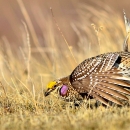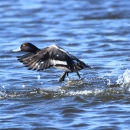Visit Us
National Wildlife Refuge System lands offer us all a chance to unplug from the stresses of daily life and reconnect with our natural surroundings. Visitors enjoy viewing the unique geology and diverse wildlife the refuge supports by viewing and photographing scenes and wildlife from roads adjacent to the refuge.
Wilderness areas are wild, undeveloped, federally protected areas where you can see wildlife in its natural habitat, enjoy adventure and unmechanized recreation, or just relish solitude. Visitor access to the Refuge is limited to protect wildlife and its habitat. Pelicans and other bird species nest on the Refuge from April through September and are easily disturbed. These birds nest on islands which provide them the vital privacy and security needed to successfully reproduce and raise young. Visitors should the refuge manager to request access to the Chase Lake Wilderness Area prior to entry for any activity not specifically identified on this site.
Activities
Chase Lake National Wildlife Refuge is a sanctuary for the American white pelican and other migratory birds. Designated as a Wilderness Area in 1975, visitor activities on the Refuge are limited. The most prominent public uses at this Refuge are hunting, wildlife viewing, and photography.
Other Facilities in the Complex
Chase Lake National Wildlife Refuge is part of the Eastern North Dakota Complex. A National Wildlife Refuge Complex is an administrative grouping of two or more refuges, wetland management districts or other refuge conservation areas that are primarily managed from a central office location. Refuges are grouped into a complex structure structure
Something temporarily or permanently constructed, built, or placed; and constructed of natural or manufactured parts including, but not limited to, a building, shed, cabin, porch, bridge, walkway, stair steps, sign, landing, platform, dock, rack, fence, telecommunication device, antennae, fish cleaning table, satellite dish/mount, or well head.
Learn more about structure because they occur in a similar ecological region, such as a watershed or specific habitat type, and have a related purpose and management needs. Typically, a project leader or complex manager oversees the general management of all refuges within the complex and refuge managers are responsible for operations at specific refuges or wetland management districts. Supporting staff, composed of administrative, law enforcement, refuge manager, biological, and fire, are centrally located and support all stations within the complex.
Rules and Policies
Help protect valuable wildlife habitat by adhering to the rules and regulations established for this Refuge.








